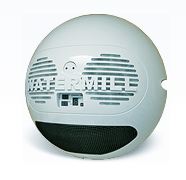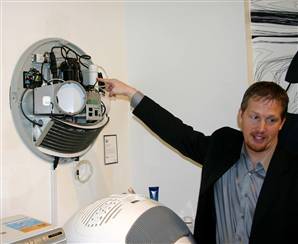 Remember those sweltering summer days when the air was so muggy you could practically drink it? A new home appliance is promising to make that possible by converting outdoor air into nearly 13 quarts of fresh water every day.
Remember those sweltering summer days when the air was so muggy you could practically drink it? A new home appliance is promising to make that possible by converting outdoor air into nearly 13 quarts of fresh water every day.
Originally envisioned as an antidote to the shortage of clean drinking water in the world, the WaterMill has the look of a futuristic air conditioner and the ability to condense, filter and sterilize water for about 3 cents per quart.
At $1,299, the 45-pound device doesn’t come cheap, and it is neither the first nor the biggest machine to enter the fast-growing field of atmospheric water generators. But by targeting individual households with a self-cleaning, environmentally friendly alternative to bottled water, Kelowna, British Columbia-based Element Four is hoping its WaterMill will become the new must-have appliance of 2009.
“The idea is making this thing intelligent,” said Jonathan Ritchey, inventor of the original WaterMill prototype and president of Element Four. “So what happens is the machine knows where it is. If you put it in a rainforest, it will sample that environment every three minutes, and it will adapt.” Ditto for a desert. That adaptation, he said during a November preview at Manhattan’s WIRED Store, is critical for energy efficiency.
Cooling the machine’s condensation chamber to just below the dew point, or the temperature at which the air becomes saturated with water vapor and begins to condense, is central to the process.
“If I have a dumb machine, it might bring the air down to just three degrees above dew point and I wouldn’t get any water,” Ritchey said.
“If I take the air way below the dew point, I’m using what’s called latent heat. It’s sort of like taking an ice cube and trying to freeze it some more. You’re just wasting your energy.”
The unit’s activated carbon filter offers another feature not found on most appliances.
“We’ve actually designed a system that knows when the filter is spent and will tell you, the consumer, ‘Time to change the filter, time to change the filter,’ Ritchey said. “And then if you don’t, we’ve got it dummy-proofed. It will shut itself down. Either you change the filter, and it makes pure water, or it doesn’t make water at all.”
Microbes are another big concern in water coolers, hot water tanks, industrial-sized air conditioning units and other places where water vapor can become contaminated.
The WaterMill was designed to overcome that issue with a self-sterilizing condensation chamber that boasts a reflective wall surrounding its condensation coil. During the machine’s daily sterilization cycle, UV light ricochets off the wall and efficiently sterilizes both the front and back sides of the coil.
Tapping a hidden reservoir
 Most environments around the world have plenty of water vapor that can be converted into liquid water. In fact, if you could wring out all the water in the air around the world and pour it into a lake, its volume would equal about 3,095 cubic miles, or more than that of Lake Superior, according to the U.S. Geological Survey.
Most environments around the world have plenty of water vapor that can be converted into liquid water. In fact, if you could wring out all the water in the air around the world and pour it into a lake, its volume would equal about 3,095 cubic miles, or more than that of Lake Superior, according to the U.S. Geological Survey.
Element Four estimates that its machine can convert between 10 percent and 40 percent of vapor into liquid water, depending on the relative humidity.
In 91 degree heat with 69 percent relative humidity, the machine tops out at a little less than 13 quarts per day. And because water vapor is continually replenished though the planet’s water cycle, removing it from the air could continue indefinitely without disrupting local ecosystems.
Ritchey said his company decided on the 13-quart capacity to maximize efficiency. Marketing data suggested that the typical family uses about half that amount of drinking water per day. But based on public perceptions that 6.5 quarts wouldn’t be enough, the company doubled the amount.
Other companies have begun producing upright units for indoor use or scaled-up outdoor units supported by fans and compressors that are capable of producing hundreds or even thousands of gallons of water per day. Miami Beach, Fla.-based Air Water Corporation, for example, can produce more than 1,000 gallons of water from a 3.5-ton mobile unit that resembles a small trailer.
Michael Zwebner, the company’s president and CEO, said 13 Air Water machines were deployed to Thailand and Sri Lanka after the 2004 tsunami. A camouflaged version is specifically aimed at the military, and units are already in use by the U.S. Marines, Indian Border Police and South African military, among other worldwide clients.
An even larger version in development can theoretically make as much as half a million liters of water a day (132,000 gallons). Later this month, the company expects to inaugurate an air-to-water facility that will give a remote Indian village its own water supply.
“The idea being that the 600 people in this village will not need to send their children many miles a day to collect water in buckets on their heads,” Zwebner said.
Likewise, Ritchey also had Third World applications in mind when he began tinkering with the WaterMill prototype in his basement nearly a decade ago.
With a model that runs on 110 volts AC and consumes about 300 watts of electricity, or the equivalent of 3,100-watt light bulbs, the company plans to branch out with a more portable unit that can operate on 12 volt DC power supplies. That modification would allow the unit to run on car batteries, photovoltaic panels, windmills or other sources of alternative energy.
More water, less energy
Greg Kail, spokesman for the American Water Works Association (AWWA), a nonprofit society focused on improving the quality and supply of drinking water, said he wasn’t familiar enough with the technology of atmospheric water generators to evaluate specific claims.
But he agreed that looming water shortages will require technological innovations, as well as more efficient devices in the home, better management at the utility level and smarter long-term planning.
Despite steady improvements in the technology that can provide fresh drinking water for about a penny per gallon in Air Water’s biggest units, according to Zwebner, that rate is still about 3.5 times more expensive than tap water production, based on the AWWA’s 2006 survey of 230 utilities throughout the U.S.
As for the WaterMill’s energy-efficient strategy, Ritchey said the unit can slow the airflow through the condenser if it needs to be cooled to a lower temperature to reach the dew point, meaning it would linger in a drier environment.
Even the WaterMill has its limits, though. Getting water when the relative humidity is less than 30 percent or 35 percent is “really pushing it,” he said.
Unlike most upright units that suck air from within a home or building, Ritchey said the WaterMill mounts on an exterior wall and uses outdoor air that is typically cleaner and more humid than indoor air.
Environmental Protection Agency-cited research suggests that the air within homes and offices can be far more polluted than outdoor air, with sources ranging from tobacco smoke and wet carpeting to cleaning products and pets.
Ritchey hopes his company’s commercial success will smooth the way for next year’s arrival of a humanitarian application called the WaterWall, essentially a stripped-down version of the WaterMill.
Within the “wall,” interconnected water condenser units can be individually engaged or disengaged as needed to overcome the problem of intermittent power in developing countries while providing a steady stream of water.
“We have a mandate as a company to do more than just make money,” he said. “We want to do some good in the world as well.”
© 2009 msnbc.com
Republished with permission of MSNBC, Turning air into water? Gadget does just that, by Bryn Nelson, December 08 2008; permission conveyed through Copyright Clearance Center, Inc.




















What an amazing device! I like how it works whether in a rain forest or a desert. Hopefully in time the price will come down and make this more accessible.
This is fantastic! I continue to be amazed by the human mind (and in many cases on this site, the human heart).
having lived in India in areas of great water scarcity and polution of existing supplies a DC current version of this with solar cells would change/save alot of livies.
Thats just amazing on so many levels.
Just think of the hundreds of millions of lives this would save worldwide.